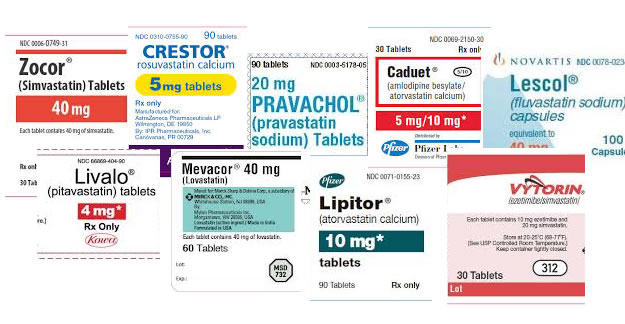Have you heard of PCSK9 inhibitors? If you read our FDA Watch post about them, you know that this new class of medication just received preliminary FDA approval as a cholesterol-lowering agent.
In a 2015 study published in the New England Journal of Medicine, participants taking PCSK9 inhibitors had LDL or “bad” cholesterol levels that were 60% lower than those who took a placebo. And indications are that side effects are minimal.
Does that mean they’ll replace statins as the go-to treatment for high LDL cholesterol? Quite the opposite, at least for now.
Still, the emergence of PCSK9 (proprotein convertase subtilisin kexin 9) inhibitors is of great interest, because there are good reasons to seek alternatives. Even with new guidelines for statins, released in 2013, widespread use of the cholesterol-lowering medications (Lipitor, Crestor, and so on) remains controversial. Those guidelines advise statin therapy for all adults with heart disease or diabetes. They also encourage adults between the ages of 40 and 75 who have at least a 7.5 percent risk of heart attack or stroke over the next 10 years, regardless of their cholesterol levels, to take a statin. (The previous guidelines prescribed statin use for adults with a 10-year risk of heart disease over 20% or LDL or “bad” cholesterol levels were above 130).
That said, even given the controversial nature of statins, they do have some benefits that are not present in the new PCKS9 medications. Statins, for example, reduce inflammation and act as anti-coagulants, reducing the risk of developing blood clots, according to David Diamond, MD, a professor of molecular pharmacology and physiology at the University of South Florida.
Then there’s the fact that that the evolocumab or alirocumab — the 2 approved PCSCK9s — are injected drugs rather than daily pills and are, at least for now, far more expensive than statins.
Browse This Article
More (and More) Statin Users
Some doctors have expressed concerns about revised statin recommendations, citing biased research and troublesome side effects. They’re far broader than former guidelines; it’s expected they’ll double the number of Americans taking the cholesterol-lowering medications to an estimated 56 million –- NEJM notes that the biggest increase is expected to be among those without cardiovascular disease. For men ages 60 to 75, the number would jump from 30% to 87%; among women in the same age group, the number of statin users would increase from 21% to 54%.
Men and women are prescribed statins in equal measure, notes John Abramson, MD, lecturer on healthcare policy at Harvard Medical School and author of Overdosed America: The Broken Promise of American Medicine. And, once statin therapy starts, patients are expected to remain on the drugs for a lifetime.
Pros and Cons of Statins
There is no question that statins do their job of lowering cholesterol. But research shows that statins might not be effective in reducing the risk of cardiac death. That is, lowering your bad (LDL) number may not actually have the desired effect of better heart-health outcomes. On that score, the research is unclear.
The authors of an article published in the February 2015 issue of Expert Review of Clinical Pharmacology criticize previous research, noting that statins are not as effective as doctors and patients have been led to believe. Nor are they as safe.
“People have been deceived and led to believe that cholesterol in the blood causes heart attacks and we need to get our cholesterol levels down to reduce our heart attack risk,” explains Diamond, the paper’s co-author, “That is untrue.”
A 2014 study published in the British Medical Journal found that people with less than a 20% risk of heart disease over the next 10 years had no significant reduction in overall mortality or cardiac mortality as a result of taking statins.
Understanding the Risks
While statins might not be effective for lowering the risk of heart disease or stroke, taking the drugs can cause significant side effects. In the BMJ study, 18% of statin users reported side effects from the medication. (A 2013 study in the Journal of Clinical Lipidology concluded that side effects, particularly muscle pain, were the most common reason people stopped taking statins.) Side effects most often associated with statin use:
- Liver injury: According to a 2014 FDA report for consumers (PDF) liver injury is a rare but possible occurrence.
- Diabetes: A small increased risk of developing diabetes has been shown in statin users. According to 2014 research reported in Diabetes Journal: “The risk of new-onset diabetes rises as adherence with statin therapy increases.” The FDA says that the benefits of statins outweigh that risk. That said, you should check with your doctor about having your blood sugar tested after starting statin therapy.
- Memory loss: This side effect, also deemed rare, is often characterized as a “fuzzy” feeling, and it stops upon stopping statin use.
- Muscle pain or weakness: In some cases, statins, particularly lovastatin, have been linked to muscle pain and a muscular weakness called myopathy.
Research has also shown a link between low cholesterol, statin use and cancer. One study found women with high cholesterol who took statins for 10 years had double the risk of an invasive form of breast cancer than those who had never taken a statin.
For those who experience side effects, Abramson suggests talking to the doctor about a “medication holiday” to see if a break from statin therapy relieves the symptoms.
“If the symptoms disappear, the doctor may want to change the dose or prescribe a different statin or even take you off of the medication altogether,” he explains.
Exploring the options
Concerns over side effects have patients exploring other options to reduce their risk of heart disease and stroke. Lifestyle changes like exercise, a healthy diet, smoking cessation and stress reduction are among the most effective.
The World Heart Federation notes that a sedentary lifestyle increases the risk of developing cardiovascular disease up to 50% while a diet high in saturated fat is responsible for about 1/3 of coronary heart disease worldwide.
Following a Mediterranean diet, which includes lots of fruits and vegetables along with healthy fats from fish, olives, avocados, seeds and nuts has been linked to a reduced risk of cardiovascular disease, according to research published in the New England Journal of Medicine.
New research shows that staying fit can help delay age-related increases in cholesterol. (Researchers defined “fit” as hitting the recommendation to engage in 150 minutes of moderate physical activity or 75 minutes of high intensity activity every week).
“In many cases, exercise, eating a healthy diet and not smoking are going to be far more effective at reducing the risk of heart disease than taking a statin,” Abramson says.
It remains to be seen if or how the PCSK9 inhibitors change the cholesterol-lowering drug market. Critics cite their so-far astronomical cost — which could reach or even exceed $10,000 a year. And while they do appear, in early results, to lower cholesterol significantly more than statins, if they also turn out to have positive effects on heart health with few or less-troubling side effects? That could be a game changer.
Further Reading
- Broader Statin Use Gets Support from 2 New Studies (New York Times)
- New Cholesterol-Lowering Drugs Hold Promise, at a Huge Projected Price Tag (USA Today)
- Federal Panel Backs Approval of New Drug to Fight Heart Attacks (New York Times)
- 10 Things You Didn’t Know About Cholesterol (Everyday Health)





